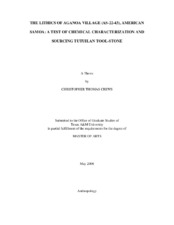| dc.description.abstract | The purpose of this thesis is to present the morphological and chemical analyses
of the lithic assemblage recovered from Aganoa Village (AS-22-43), Tutuila Island,
American Samoa. Implications were found that include the fact that Aganoa Village did
not act as a lithic workshop, new types of tools that can be included in the Samoan tool
kit, a possible change in subsistence strategies through time at the site, and the fact that
five distinct, separate quarries were utilized at different stages through the full temporal
span of residential activities at the village.
The assemblage was analyzed macroscopically using typologies for tools that are
set and accepted by archaeologists of the area (Green and Davidson [1969] for adzes,
Clark and Herdrich [1993] for flake tools). It was found that a possible new flake tool
type is represented at Aganoa Village that combines the attributes of Class Ia and Class
V. Analysis of the debitage refutes earlier conclusions that the site represents a lithic
workshop. The presence of rejuvenation flakes with polish, a large amount of tertiary debitage as opposed to primary debitage, and the recycling/conservation of finished
adzes indicates that this site was indeed not a lithic workshop area.
In the earliest cultural period (c 2500-2000 years ago) there is a distinct lack of
flake tool scrapers while the other two cultural periods presented 40 examples of such
tools. These scrapers are used primarily for processing agricultural products. The fact
that these tools are missing from the earliest settlement period suggests that these early
inhabitants might have relied more on gathering marine resources from the nearby reef
system rather then agricultural subsistence strategies.
Finally, INAA results show that the lithic artifacts collected come from five
different sources. Two of these sources were identified as the Lau'agae Quarry on the
eastern side of Tutuila Island and the Tataga-Matau Quarry Complex located on the
western portion of the island. Three other basalt types were distinguished but not
sourced or located. | en |


